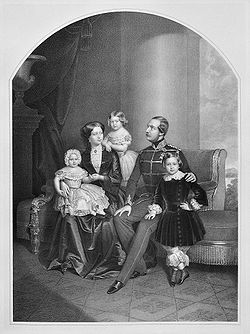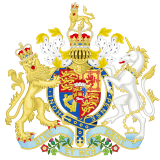- George V of Hanover
-
George V 
King of Hanover Reign 18 November 1851 – 20 September 1866 Predecessor Ernest Augustus I Duke of Cumberland and Teviotdale Predecessor Ernest Augustus I Successor Ernest Augustus II Consort Marie of Saxe-Altenburg Issue Ernest Augustus, Crown Prince of Hanover
Princess Frederica of Hanover
Princess Marie of HanoverFull name George Frederick Alexander Charles Ernest Augustus
German: Georg Friedrich Alexander Karl Ernst AugustHouse House of Hanover Father Ernest Augustus I of Hanover Mother Frederica of Mecklenburg-Strelitz Born 27 May 1819
Berlin, PrussiaDied 12 June 1878 (aged 59)
Paris, FranceBurial St George's Chapel, Windsor George V (George Frederick Alexander Charles Ernest Augustus; 27 May 1819 – 12 June 1878) was King of Hanover, the only child of Ernest Augustus I, and a grandchild of King George III of the United Kingdom. In the peerage of Great Britain, he was 2nd Duke of Cumberland and Teviotdale, 2nd Earl of Armagh. He was the fifth and final King of Hanover.
George V, a first cousin of Queen Victoria, inherited the Hanoverian realm (which could not pass to Victoria because of Salic law) through his father, who ascended the throne of Hanover in place of Victoria. George spent his childhood in Berlin and in Britain, losing the sight of one eye following a childhood accident and illness in 1828.[1] He lost the sight in the other eye in 1833.[2] His uncle, William IV, created him a Knight of the Garter on 15 August 1835. His father had hoped that the young prince might marry his cousin Victoria, thus keeping the British and Hanoverian thrones united, but nothing ever came of that desire and on King William's death, Victoria became Queen of the UK and George became 1st in line to the Hanoverian throne and 2nd in line to the British throne (after his father).
Contents
Early life
Prince George of Cumberland was born in Berlin, the only son of Prince Ernest Augustus, Duke of Cumberland, himself fifth son of George III, and his wife, Princess Frederica, Duchess of Cumberland.
He was baptized on 8 July 1819, at a hotel in Berlin where his parents were staying, by the Rev. Henry Thomas Austen (brother of author Jane Austen). His godparents were The Prince Regent (represented by The Duke of Cumberland), The King of Prussia, The Emperor of Russia, The Crown Prince of Prussia, Prince William of Prussia, Prince Frederick Louis of Prussia, Prince Henry of Prussia, Prince William of Prussia, The Grand Duke of Mecklenburg-Strelitz, Duke Charles of Mecklenburg-Strelitz, The Empress Maria Feodorovna of Russia, The Queen of the Netherlands, The Princess Augusta, The Hereditary Princess of Hesse-Homburg, The Duchess of Gloucester and Edinburgh, The Princess Sophia, Princess Alexandrine of Prussia, The Electoral Princess of Hesse-Kassel, The Duchess of Anhalt-Dessau, Princess William of Prussia, The Dowager Princess Ferdinand of Prussia, Princess Louisa of Prussia and The Princess Radziwill.[3]
Crown Prince
Upon the death of William IV and the accession of Queen Victoria to the British throne, the 123-year personal union of the British and Hanoverian thrones ended due to the operation of Salic Law in the German states. The Duke of Cumberland succeeded to the Hanoverian throne as Ernst August I, and Prince George became the Crown Prince of Hanover. As a legitimate male-line descendant of George III, he remained a member of the British Royal Family, and second in line to the British throne, until the birth of Queen Victoria's first child, Victoria, Princess Royal, in 1840. Since he was totally blind, there were doubts as to whether the Crown Prince was qualified to succeed as king of Hanover; but his father decided that he should do so.
 George V of Hanover, his wife Marie of Saxe-Altenburg and their children Ernest Augustus, Crown Prince of Hanover, Princess Frederica of Hanover, and Princess Marie of Hanover
George V of Hanover, his wife Marie of Saxe-Altenburg and their children Ernest Augustus, Crown Prince of Hanover, Princess Frederica of Hanover, and Princess Marie of Hanover
Marriage
George married, on 18 February 1843, at Hanover, Princess Marie of Saxe-Altenburg, the eldest daughter of Joseph, Duke of Saxe-Altenburg, by his wife, Duchess Amelia of Württemberg.
King of Hanover
The Crown Prince succeeded his father as the King of Hanover and Duke of Brunswick-Lüneburg, as well as Duke of Cumberland and Teviotdale, in the Peerage of Great Britain, and Earl of Armagh, in the Peerage of Ireland, on 18 November 1851, assuming the style George V.
From his father and from his maternal uncle, Prince Charles Frederick of Mecklenburg-Strelitz, one of the most influential men at the Prussian court, George had learned to take a very high and autocratic view of royal authority. During his 15-year reign, he engaged in frequent disputes with the Hanoverian parliament. Having supported Austria in the Diet of the German Confederation in June 1866, he refused, contrary to the wishes of his parliament, to assent to the Prussian demand that Hanover should observe an unarmed neutrality during the Austro-Prussian War. As a result, the Prussian army occupied Hanover and the Hanoverian army surrendered on 29 June 1866, the King and royal family having fled to Austria. The Prussian government formally annexed Hanover on 20 September, but the deposed King never renounced his rights to the throne nor acknowledged Prussia's actions. From exile in Gmunden, Austria, he appealed in vain for the European great powers to intervene on behalf of Hanover. From 1866, George V maintained the Guelphic Legion at his own expense.
Death
George V died in Paris in June 1878. He was buried in St George's Chapel at Windsor Castle.
Legacy
The king supported industrial development – in 1856 the "Georgs-Marien-Bergwerks- und Hüttenverein" was founded which was named after him and his wife. The company erected an iron and steel works which gave the city Georgsmarienhütte its name.
Titles, styles, honours and arms
Titles and styles
- 27 May 1819 – 20 June 1837: His Royal Highness Prince George of Cumberland
- 20 June 1837 – 18 November 1851: His Royal Highness The Crown Prince of Hanover
- 18 November 1851 – 12 June 1878: His Majesty The King of Hanover
Arms
By grant dated 15 August 1835, George's arms in right of the United Kingdom were those of his father (being the arms of the United Kingdom, differenced by a label argent of three points, the centre point charged with a fleur-de-lys azure, and each of the other points charged with a cross gules), the whole differenced by a label gules bearing a horse courant argent.[4]
Ancestors
George's ancestors in three generations George V of Hanover Father:
Ernest Augustus I of HanoverPaternal grandfather:
George III of the United KingdomPaternal great-grandfather:
Frederick, Prince of WalesPaternal great-grandmother:
Augusta of Saxe-GothaPaternal grandmother:
Charlotte of Mecklenburg-StrelitzPaternal great-grandfather:
Charles Louis Frederick, Duke of Mecklenburg-MirowPaternal great-grandmother:
Elizabeth Albertine of Saxe-HildburghausenMother:
Frederica of Mecklenburg-StrelitzMaternal grandfather:
Charles II, Grand Duke of Mecklenburg-StrelitzMaternal great-grandfather:
Charles Louis Frederick, Duke of Mecklenburg-MirowMaternal great-grandmother:
Elizabeth Albertine of Saxe-HildburghausenMaternal grandmother:
Friederike of Hesse-DarmstadtMaternal great-grandfather:
Prince Georg Wilhelm of Hesse-DarmstadtMaternal great-grandmother:
Maria Louise Albertine of Leiningen-Falkenburg-DagsburgIssue
Name Birth Death Notes Ernest Augustus, Crown Prince of Hanover 21 September 1845 14 November 1923 Ernest Augustus William Adolphus George Frederick; born at Hanover, died at Gmunden, married Princess Thyra of Denmark; had issue Princess Frederica of Hanover 9 January 1848 16 October 1926 born at Hanover, died at Biarritz; married Alfons, Baron von Pawel-Rammingen; had no surviving issue Princess Marie of Hanover 3 December 1849 4 June 1904 Marie Ernestine Josephine Adolphine Henrietta Theresa Elizabeth Alexandrina; born at Hanover, died unmarried at Gmunden References
- ^ Letter to the Times dated July 3rd by William Christian Sellé
- ^ Letter to the Times dated July 5th by William Christian Sellé
- ^ London Gazette: no. 17497. p. 1296. 24 July 1819. Retrieved 2008-06-19.
- ^ Marks of Cadency in the British Royal Family
External links
George V of HanoverBorn: 27 May 1819 Died: 12 June 1878Regnal titles Preceded by
Ernest Augustus IKing of Hanover
18 November 1851 – 20 September 1866Office abolished
Peerage of Great Britain Preceded by
Ernest Augustus IDuke of Cumberland and Teviotdale
18 November 1851 – 12 June 1878Succeeded by
Ernest Augustus IIPeerage of Ireland Preceded by
Ernest Augustus IEarl of Armagh
18 November 1851 – 12 June 1878Succeeded by
Ernest Augustus IITitles in pretence Loss of title
— TITULAR —
King of Hanover
20 September 1866 – 12 June 1878Succeeded by
Ernest Augustus IIRulers of Hanover Electors of Hanover Kings of Hanover - Also monarch of Great Britain or the United Kingdom.
British princes The generations indicate descent from George I, who formalised the use of the titles prince and princess for members of the British Royal Family.1st generation 2nd generation 3rd generation 4th generation George IV · Prince Frederick, Duke of York and Albany · William IV · Prince Edward, Duke of Kent and Strathearn · Ernest Augustus I of Hanover · Prince Augustus Frederick, Duke of Sussex · Prince Adolphus, Duke of Cambridge · Prince Octavius · Prince Alfred · Prince William, Duke of Gloucester and Edinburgh
5th generation Albert, Prince Consort[1] · George V of Hanover · Prince George, Duke of Cambridge
6th generation 7th generation Prince Albert Victor, Duke of Clarence and Avondale · George V · Prince John of Wales · Alfred, Hereditary Prince of Saxe-Coburg and Gotha · Prince Arthur of Connaught · Charles Edward, Duke of Albany and of Saxe-Coburg and Gotha · Prince George William of Hanover · Prince Christian of Hanover · Ernest Augustus, Duke of Brunswick
8th generation Edward VIII · George VI · Prince Henry, Duke of Gloucester · Prince George, Duke of Kent · Prince John · Alastair Windsor, 2nd Duke of Connaught and Strathearn · John Leopold, Hereditary Prince of Saxe-Coburg and Gotha · Prince Hubertus of Saxe-Coburg and Gotha · Prince Ernest Augustus of Hanover · Prince George William of Hanover
9th generation 10th generation 11th generation 1 Not a British prince by birth, but created Prince Consort. 2 Not a British prince by birth, but created a Prince of the United Kingdom.Prince Rupert of the Rhine (1644-1682) · George of Denmark (1683-1708) · Prince William (1726-1765) · Prince Henry (1766-1790) · Ernest Augustus I of Hanover (1771-1851) · George V of Hanover (1851-1878) · Ernest Augustus II of Hanover (1878-1919)Hanoverian princes 1st generation 2nd generation George V* · George, Duke of Cambridge*
3rd generation 4th generation Prince George William* · Prince Christian* · Ernest Augustus, Duke of Brunswick*
5th generation Ernest Augustus IV, Prince of Hanover* · Prince George William* · Prince Christian Oscar · Prince Welf Henry
6th generation Prince Welf Ernest · Prince George · Ernst August V, Prince of Hanover · Prince Louis Rudolph · Prince Henry Julius
7th generation Prince Ernest Augustus · Prince Christian · Prince Otto Henry · Prince Albert · Prince Julius
Categories:- Kings of Hanover
- Princes of the United Kingdom
- Hanoverian princes
- House of Hanover
- Knights of the Garter
- Knights Grand Cross of the Royal Guelphic Order
- Knights of the Golden Fleece
- Dukes in the Peerage of the United Kingdom
- Dukes of Cumberland and Teviotdale
- People from Berlin
- 1819 births
- 1878 deaths
- Blind people
- Crown Princes of Hanover
- Knights Grand Cross of the Order of Saint Stephen of Hungary
- Recipients of the House Order of the Wendish Crown
Wikimedia Foundation. 2010.



